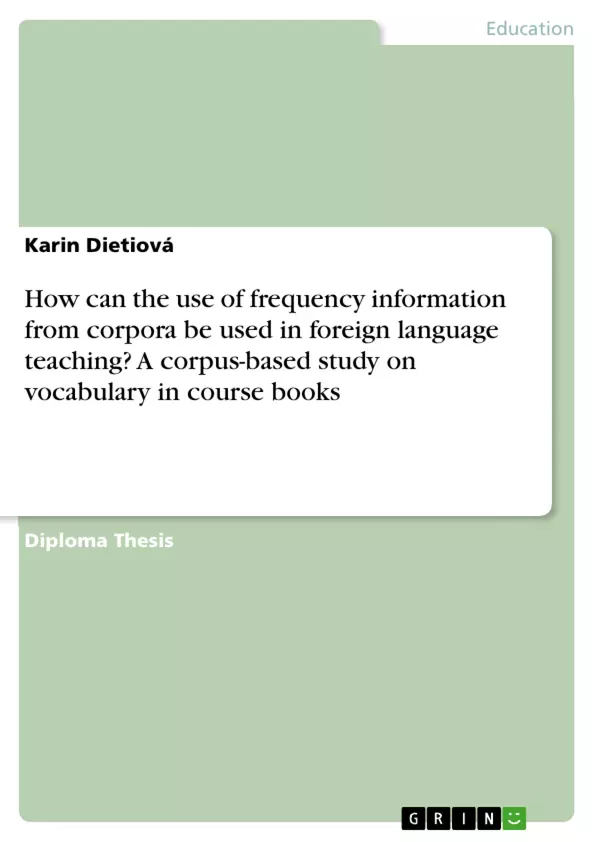How can corpora be used to improve vocabulary learning in language acquisition? This thesis focuses on the use of word-frequencies by teachers of English.
Teaching vocabulary to young learners is one of the most challenging responsibilities that teachers face. The methodology chosen for the presentation of vocabulary is crucial for the learning success of the students. There is a great amount of studies on how computers can facilitate the learning of English as a foreign language (EFL) and with the development of immense corpora both teachers and students now have access to hundreds of millions of words and the possibility to explore their occurrence patterns. This advantage is, however, rarely used in practice, partly due to the relatively short existence of this discipline but most importantly due to the lack of information about corpora in English language teaching (ELT).
This paper will present the concept of course book vocabulary and present word frequencies in learner's dictionaries. The research part of this thesis deals with a linguistic analysis of data extracted from course books and their comparison with the Oxford list of 3000 essential words. The aim of the thesis is to investigate the linguistic attributes of texts forming course books and to examine their relation.
Inhaltsverzeichnis (Table of Contents)
- Introduction
- Coursebook vocabulary
- Project coursebooks in primary education
- Project home study program
- Word frequency in current learner's dictionaries
- Oxford defining vocabulary
- Longman defining vocabulary
- Corpus linguistics in language learning
- Research
- Goal of research
- Development of methods and tasks
- Coursebook series selection
- Acquisition of data
- Questionnaires
- Mistakes and errors
- Compliance of the corpus
- Corpus compliance/builder programs
- Corpus preparation and importation
- Part of speech tagging and lemmatization
- Co-occurrence analysis
- Thematic analysis
- Comparative analysis
- Oxford 3000 corpus
- Output interpretation
- Questionnaires
- Project 1
- Word list derived analysis
- Co-occurrence analysis
- Thematic analysis and data mining
- Comparative analysis
- Mistakes and errors
- Project 2
- Word list derived analysis
- Co-occurrence analysis
- Thematic analysis and data mining
- Comparative analysis
- Mistakes
- Project 3
- Word list derived analysis
- Co-occurrence analysis
- Thematic analysis and data mining
- Comparative analysis
- Mistakes
- Project 4
- Word list derived analysis
- Co-occurrence analysis
- Thematic analysis and data mining
- Comparative analysis
- Mistakes
- Project 5
- Word list derived analysis
- Co-occurrence analysis
- Corpus linguistics application in analyzing coursebooks
- Vocabulary representation in Project coursebooks
- Comparison of coursebook vocabulary with The Oxford 3000 list
- Analysis of word frequency and co-occurrence patterns
- Investigation of thematic trends within the corpus
Zielsetzung und Themenschwerpunkte (Objectives and Key Themes)
The aim of this thesis is to examine the fourth edition Project coursebooks series using corpora created specifically for this study, applying corpus linguistics principles. The analysis compares the vocabulary representation in these corpora, both individually and collectively, to the content of The Oxford 3000 list of essential words.
Zusammenfassung der Kapitel (Chapter Summaries)
The thesis commences with an introduction providing context and outlining the research objectives. The next chapter delves into the concept of coursebook vocabulary, followed by an exploration of the Project coursebooks in primary education, including the home study program. The fourth chapter examines word frequency in dictionaries, focusing on Oxford and Longman defining vocabulary, and the role of corpus linguistics in language learning.
The research section details the goals, methodology, and specific tasks employed. This includes the selection of the coursebook series, data acquisition, questionnaires, and the analysis of mistakes and errors. The chapter also describes the compliance of the corpus, outlining the processes of corpus building, preparation, part of speech tagging, lemmatization, co-occurrence analysis, thematic analysis, comparative analysis, and the use of the Oxford 3000 corpus.
The output interpretation section analyzes the findings from the questionnaires and focuses on individual Project coursebooks, examining the word list derived analysis, co-occurrence analysis, thematic analysis and data mining, comparative analysis, and mistakes and errors. These analyses are conducted for Project 1, Project 2, Project 3, Project 4, and Project 5.
Schlüsselwörter (Keywords)
The primary keywords and focus topics of this thesis include corpus linguistics, Project coursebooks series, vocabulary, English language teaching, The Oxford 3000 list, word frequency, co-occurrence analysis, thematic analysis, and error analysis. This study utilizes corpus linguistics tools to investigate the vocabulary representation and thematic patterns within the Project coursebooks series, comparing these findings to a benchmark vocabulary list.
- Quote paper
- Karin Dietiová (Author), 2016, How can the use of frequency information from corpora be used in foreign language teaching? A corpus-based study on vocabulary in course books, Munich, GRIN Verlag, https://www.grin.com/document/454836



